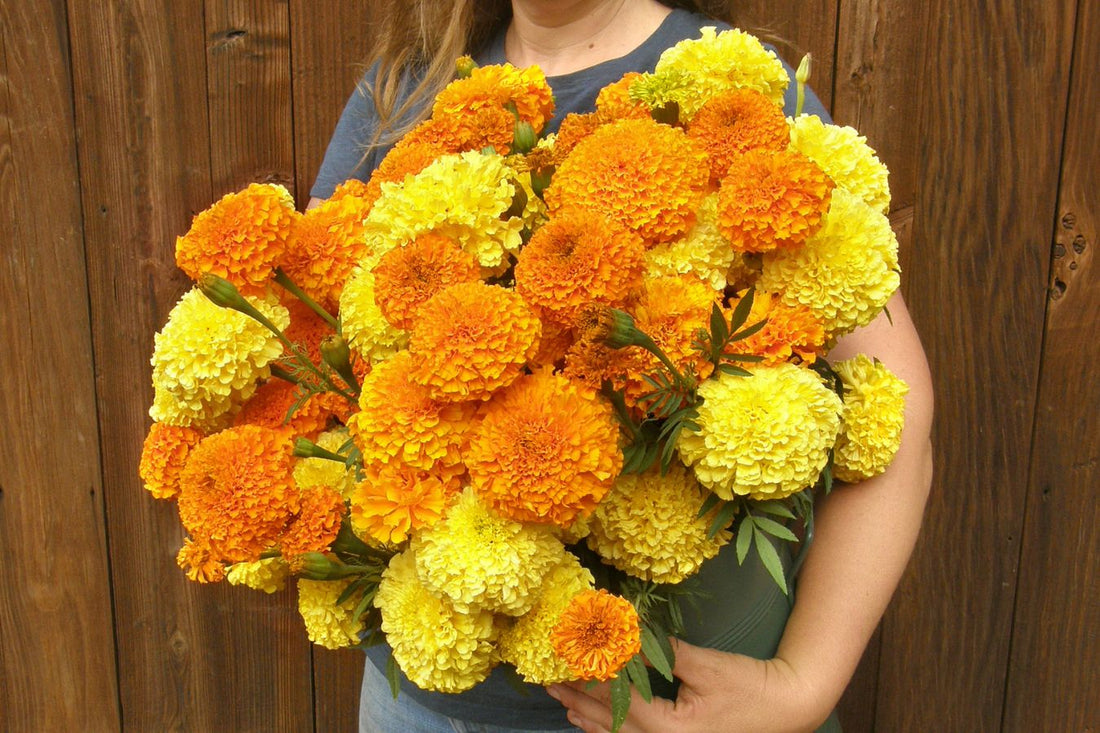
I get many letters from excited gardeners asking about what flowers to grow for weddings and how to plan the seed sowing and growing process. Having done this myself and had the pleasure of walking my daughter down a garden path flanked by glorious tall, branching sunflowers, I know the appeal of growing your own wedding flowers, filled with your own personal love and joy for that special day…. Here are some helpful ideas and advice I can offer:
Foremost is the issue of how to time planting the seeds and transplanting to allow for the vagaries of weather. Renee's packet backs are written so you get a sense of what conditions a plant needs, rather than specific dates, since the weather and timing can vary so much in different regions and even within microclimates. Packet backs will tell you which flowers like to grow and bloom in cool weather, and which ones need warm nights before the seedlings can go outside.
Before we go any further, a word to the wise: growing your own flowers can make for a lot of anxiety close to the date. It is important to be pragmatic and have a back-up plan ready in case of unseasonable and/or bad weather, deer or rabbit invasions. Establish a source for garden flowers (a flower vendor at the farmers market or a local grower is always the best). Be sure to check in with your backup source close to the event, so if your flowers aren't performing as expected, you have the reassurance that you will be able to fill in as needed.
The truth is that every season is different and timing from seed to bloom can vary so much year to year that it's hard to always accurately estimate bloom time. That said, there are different groups of annual flowers that come into bloom at certain times. Always plan to make a few sowings in a two-week succession (the second planting done two weeks after the first), so you can be more confident about germination success and more assured that you will have blooming flowers available.
For spring weddings in mild winter climates (USDA zones 9 and 10 where ground does not freeze) hardy annuals like Larkspur, Nigella, Calendula, Clarkia, Agrostemma, Poppies, Snapdragons, White Bishop's Lace, Stock and Sweet Peas can be sown in fall to use for early spring weddings (late-April).
For later spring weddings (mid-May) in mild climates, and early summer weddings in colder climates, you can sow this same list of flowers in very early spring: they will bloom over a good few weeks, especially if you keep them deadheaded (removing spent flowers to encourage more to bloom).
Flowers that come into their own in summer and make good mid-summer wedding material include Cosmos, Zinnias, Marigolds, Tithonia, Sunflowers (more bloom time leeway with the branching types like Sun Samba), Salpiglossis, Salvia and Bells of Ireland. Seeds can be sown directly in the ground once nights have warmed up above 50° F (10° C), or started in flats according to packet directions. You can expect bloom in 70 to 85 days.
Perennials like Echinacea, Carnations, Columbine, Delphinium, Feverfew, and Foxgloves can be glorious additions, but usually don’t bloom freely enough until the year after sowing, so it would depend on your planning time. Feed plants a month before the wedding date and as they begin to flower. Be sure you supply enough moisture if natural rains aren't generous. Mulching is critical where it gets hot early to keep plants in good shape and making new buds.
Even if you are planning to buy certain florist's flowers to satisfy a bride's preferences such as Roses, Lilies, Lisianthus, Gerbera Daisies or Gladiolus, using your home-grown blooms in the mix will give a really unique garden look to hand-held bouquets, table arrangements, corsages and boutonnieres. Choose flowers such as Bells of Ireland, White Bishop's Lace, Zinnias, Cerinthe, and branches of both perennial and annual herbs like Oregano, Purple Basil, Lavender, Rosemary, Fennel and Mint. Depending on the season, you also cut foliage from your garden shrubs to extend and personalize bouquets. I've even seen ornamental purple kale and wild oats in whimsical and field-themed table bouquets. Both of Renee's Amaranth varieties, Love Lies Bleeding and Cinco de Mayo make dramatic accents.
For flowers that will be worn on lapels or as head wreaths, choose varieties that will hold up well for a few hours without water, such Globe Amaranth, Carnations, Cornflowers and Rudbeckia. Stems may need to be wound with light florist wire as well as taped to keep them from flopping.
The most memorable brides' bouquets I've created were for easy-going brides who just wanted to have the most beautiful flowers in the garden at the time of the wedding. Remember, you will need to pick a day or two before so the flowers can soak up water before the stress of handling and preparing arrangements. Then cut the stems again before working with them. It's amazing how just a small handful of garden flowers can really shine in a bouquet when set off by other greens and filler.
Most of the flowers listed above will provide nectar to butterflies, hummingbirds, and other pollinators, so your garden will be pleasing not only to the couple for their wedding day, but also for beneficial insects and pretty winged visitors in the days leading up to to the wedding.
